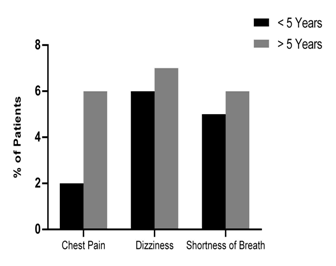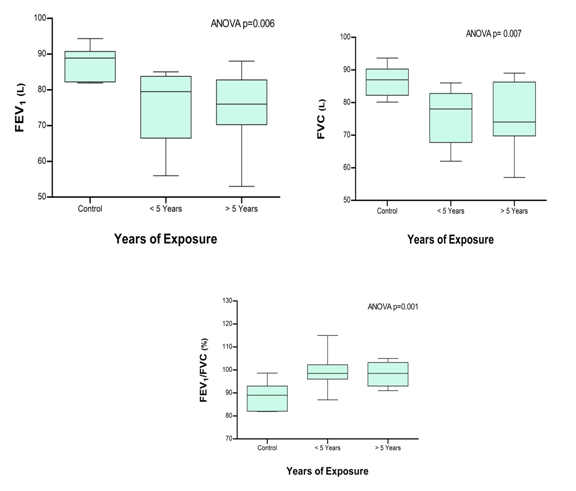Journal of
eISSN: 2376-0060


Proceeding Volume 2 Issue 3
Jazan University, Prince Sultan Military College of Health Sciences, Dammam University, Saudi Arabia
Correspondence: Rami Alyami, Jazan University, Saudi Arabia
Received: February 25, 2015 | Published: April 1, 2015
Citation: Alyami R, Alomar J, Alobireed A, et al. Exposure to vehicle exhaust causes decline in lung functions. J Lung Pulm Respir Res. 2015;2(3):53–55. DOI: 10.15406/jlprr.2015.02.00042
Introduction: Air pollution from vehicles is an inevitable part of the workers at gasoline stations. A long-term exposure to such air pollution of vehicles exhaust would leads to damaging effects on general health and the pulmonary function in particular. A number of studies have found an increased prevalence of respiratory symptoms in populations live near roadways with high traffic counts.
Aims and objectives: The present study was aimed to investigate the extent of pulmonary function changes due to exposure to exhaust vehicles on car maintenance workers at gas stations in Eastern Province, Saudi Arabia. Furthermore, we also assessed the relationship between the duration of the service at the gas stations with pulmonary function decline.
Materials and methods: Twenty males aged from 18-40years whom working in gas stations as a cars mechanics were recruited in this study. Studied subjects were categorized into two groups, depending on the duration of the exposure [first group >5-years; second group <5years]. Pulmonary function parameters were measured as FEV1, FVC and FEV%, using portable spirometry during their working hours. For air pollution, MIRAN SapphIRe Portable Ambiant Analyzer, GrayWolf and Aerosol and Dust Monitors were used and its value was compared with World Health Organization (WHO) and Saudi standards.
Results: Shortness of breath, dizziness and chest pain were the most prevalent symptoms among workers. Workers with less than 5 years showed symptoms as follow: 10%, 30% and 25%; while the workers with more than 5years: 30%, 35% and 30%. FVC (L) and FEV1 (L) data showed significant decrease compared to the control group [ANOVA p=0.006; ANOVA p=0.007], while FEV1% (FEV1/FVC) value showed significant increase compared to the control group [ANOVA p=0.001]. Air pollution data showed a significant increase in dust, NO2, VOC and SO2 comparing with WHO and Saudi Standards.
Conclusions: Gasoline fumes showed to have adverse effects on pulmonary functions of car maintenance workers at gas stations especially in lower airways with restrictive type of pulmonary disease. In order to prevent lung damage in car maintenance workers at gas stations, awareness programs should be conducted and periodic medical pulmonary function tests checkups should be conducted to detect any pulmonary function impairment at the earliest.
Keywords: vehicle exhaust, air pollution, pulmonary function test (PFT), respiratory symptoms
Air pollution from vehicles is an inevitable part of the workers at gasoline stations. A long-term exposure to vehicles exhaust leads to damaging effects on the respiratory function.1 The present study aimed to investigate the extent of lung function changes due to exposure to exhaust vehicles on car maintenance workers at gas stations. We also assessed the effect of the duration of the service at the gas stations on lung function decline.
Gas stations in Dammam, Eastern Province, Saudi Arabia
Twenty males aged from 18-40years whom working in gas stations as a cars mechanics were recruited in this study (Table 1). They were categorized into two groups, depending on the duration of the exposure [first group >5-years; second group <5years]. Lung function parameters were measured as FEV1, FVC, FEV% and FEF1 (25-75), using portable spirometry during their working hours. For air pollution, MIRAN Sapphire Portable Ambient Analyzer, Gray Wolf and Aerosol and Dust Monitors were used and its value was compared with World Health Organization (WHO) and Saudi standards. Data were analyzed using Graph Pad Prism 5 software (Graph Pad Software Inc., La Jolla, CA, USA). The Kolmogorov–Smirnov test of normality was applied. Descriptive analysis was applied. A one-way ANOVA was run to examine differences between the groups, followed by post hoc Bonferroni multiple comparison tests. A p-value 0.05 was considered statistically significant.
Subjects n=20 |
Mean |
SD |
Gender male % |
100 |
|
Age (yrs) |
25.9 |
5.90 |
Weight (kg) |
79.6 |
12.79 |
Height (cm) |
169.7 |
4.50 |
Length of service at gasoline station (yrs) |
4.22 |
3.62 |
Days of Work per week |
7 |
0 |
Hours of Work per day |
14.25 |
1.33 |
Table 1 Demographic information of gasoline workers enrolled in this study
The most prevalent symptoms of workers were shortness of breath, dizziness and chest pain. Workers with less than 5years showed symptoms as follow: 10%, 30% and 25%; while the workers with more than 5years: 30%, 35% and 30% (Figure 1).

Figure 1 Comparison for the respiratory symptoms between the gas stations workers depending on the duration.
FVC (L) and FEV1 (L) data showed significant decrease compared to the control group [ANOVA p=0.006; ANOVA p=0.007], while FEV1/FVC% value showed significant increase compared to the control group [ANOVA p=0.001] (Figure 2).

Figure 2 Mean value of lung function tests in gas stations workers according to duration of exposure. Significant differences illustrated using ANOVA with post hoc analysis. Lines represent mean ± SD.
Air pollution data showed a significant increase in dust, NO2, VOC and SO2 comparing with WHO and Saudi Standards, as illustrated in Figure 3A, Figure 3B.
The above findings point towards adverse effects of gasoline fumes on lung functions, mainly on lower airways with restrictive pattern of disease.
None.
The author declares no conflict of interest.

©2015 Alyami, et al. This is an open access article distributed under the terms of the, which permits unrestricted use, distribution, and build upon your work non-commercially.
 November is Lung Cancer Awareness Month, a vital opportunity for us to raise awareness about the dangers of lung cancer. Let’s unite to educate ourselves and others, and inspire proactive steps toward lung health. This year the motto of this event is “Stronger Together: United for Lung Cancer Awareness”. So for this occasion, the Journal of Lung, Pulmonary & Respiratory Research invites articles that emphasize the significance of lung protection. All the submissions received in the month of November will be offered with 40% discount on publication.
November is Lung Cancer Awareness Month, a vital opportunity for us to raise awareness about the dangers of lung cancer. Let’s unite to educate ourselves and others, and inspire proactive steps toward lung health. This year the motto of this event is “Stronger Together: United for Lung Cancer Awareness”. So for this occasion, the Journal of Lung, Pulmonary & Respiratory Research invites articles that emphasize the significance of lung protection. All the submissions received in the month of November will be offered with 40% discount on publication.